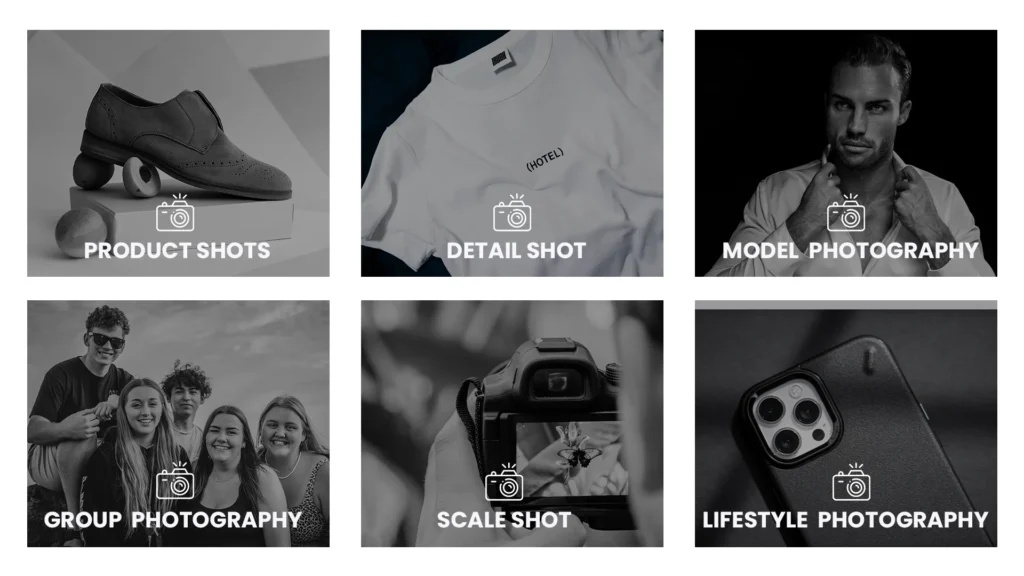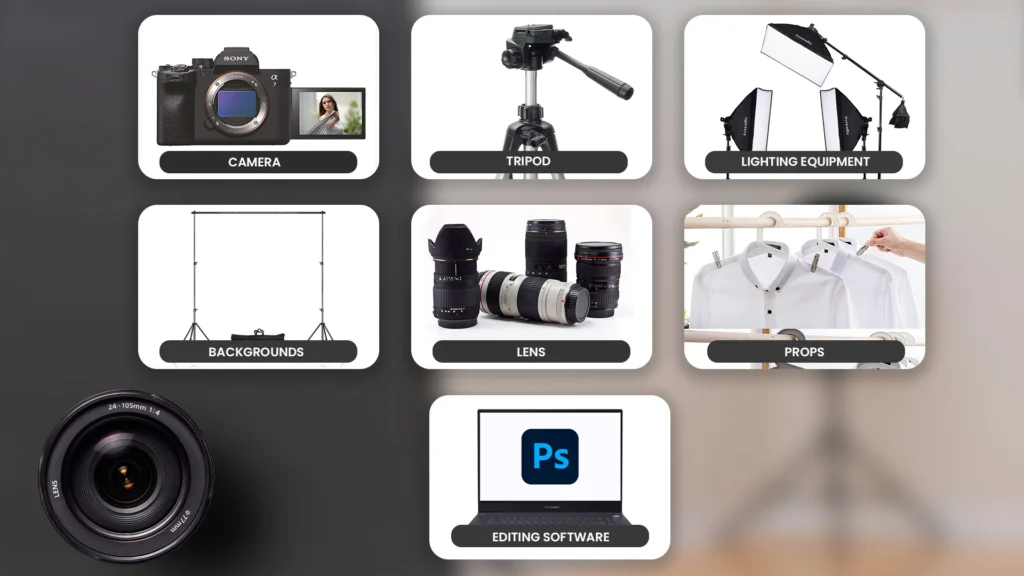Did you know that 22% of internet purchases result in returns because the goods don’t match the pictures? Your customers’ expectations of what they are looking at are formed by taking expert product photos that communicate the correct story. Additionally, they are concerned that the goods won’t meet their expectations.
For any business operating on ecommerce platforms, it is crucial to illustrate the look and feel of the product via product photography. Since the consumers are seeing your product without touching it, ecommerce businesses need to present the product in a way that is visually appealing to your consumers. Here’s where the role of ecommerce photography comes into the picture.
To exhibit products in a way that encourages engagement, sales, and client loyalty, photoshoot for online products is essential to the success of online enterprises.
What is Ecommerce Photography?
Ecommerce photography is the process of taking pictures of goods that are being sold online. To help potential buyers make informed decisions about what to buy, Ecommerce Shoot aims to present products accurately and appealingly. Unquestionably, an image has power, particularly in online advertising. When you post high-quality product photos on your website or social media pages, your chances of making many sales increase. Increased sales correlate with the expansion of business.
Types of Ecommerce Photography
Customers are always drawn to images before reading the text on the website. This suggests that ensuring your product images are appealing and of the highest caliber is imperative.
Whether using pictures from your manufacturer or investing on your own for the product photoshoot, you must understand the different types of product photography required for an eCommerce business.

In this article, we have curated the different types of images that you can use for your marketing campaigns and promotion.
1) Product – Only image is the simplest form of product photography that you can conduct. Simply place your product against a solid background (a studio or your home), and click pictures of the product.
2) Lifestyle photography – is a style where professionals place your product in a way that showcases the product in real-life situations.
3) In-process photography – is the photography style. The photographer captures shots of the products being crafted and manufactured.
4) Scale Shot – When consumers buy online, the foremost concern that comes into their minds is the size of the product. This is where the role of scale shot comes into place.
5) Detail Shot – Detail shots are close-up photographs of your goods. The best aspects and angles of your products can be highlighted for potential customers using this style of product photography. This is best suited when you are in the clothing business.
6) Model Photography – Models are used in model photography to display clothing and accessories. Customers can better picture a product’s appearance and fit on a person with this style of photography.
7) Group Photography – Several products are photographed together in this form of photography, either as a collection or in a specific arrangement. Customers may then be able to observe how certain products work well together or how they fit into a collection.
Why is Professional Photography Essential for E-Commerce?
In this digital era, displaying compelling and attractive visuals for your e-commerce business has become essential. It helps persuade and convince clients to purchase or click on any product listed on any marketplace. Also, quality visuals represent your brand image, so having good photography is very important for your ecommerce business.
It enhances visual appeal, makes a solid first impression, and positively influences the perception of your brand. Accurately showcasing your products lets customers understand their features, details, and overall aesthetics. It builds trust and credibility, demonstrating your commitment to quality and professionalism. Good photography also differentiates your business and establishes a unique brand identity.
It improves conversion rates by reducing doubts and hesitations, leading to increased sales. Additionally, it provides valuable content for social media, digital advertising, and marketing campaigns, attracting new customers and expanding your brand reach. Investing in professional photography or developing in-house expertise can significantly benefit your online store’s success.
How to Set Up Your Studio for E-Commerce Photography?
Setting up a studio for e-commerce photography requires careful planning and attention to detail. Always consider following steps before setting up your studio:
1) Find a dedicated space: Choose a large enough space to accommodate your photography setup, products, and props. Ensure good lighting conditions and the ability to control natural light.
2) Lighting equipment: Invest in quality lighting equipment such as strobes, soft boxes, and reflectors. These tools will help you achieve well-lit and evenly illuminated product photos.
3) Backgrounds and props: Select a variety of backgrounds and props that complement your products and enhance their visual appeal. Consider using seamless paper, fabric backdrops, or tabletops with different textures and colors.
4) Product staging and arrangement: Develop a system for effectively staging and arranging your products. This may involve using display stands, mannequins, or flat-lay techniques to showcase your items best.
5) Camera and equipment: Choose a high-quality camera to capture detailed product images. Additionally, invest in lenses suitable for product photography, a tripod for stability, and a remote shutter release for minimizing camera shake.
6) Post-processing software: Use photo editing software like Adobe Photoshop or Lightroom to enhance and retouch your product images. This will help ensure consistency and professionalism in your final images.
Remember, the key is to create visually appealing and accurate representations of your products to attract potential customers. With careful planning and attention to detail, you can set up a professional studio for e-commerce photography or follow Spyne
Benefits of Ecommerce Photography
Nowadays, more and more companies are increasing their online stores by utilizing the various advantages of product photography, and for a good reason.
When done correctly, product photography is an investment for businesses since it helps them increase sales, establish a reputation, and differentiate themselves from rivals.

There are plenty of benefits of ecommerce photography, and a few of them are:
1) Increase online visibility– If your products look appealing online, it aids in visual merchandising. To attract clients online and increase brand awareness, eye-catching product photos are frequently the foundation of many content marketing initiatives.
2) Building Trust and Credibility: When customers shop online, they cannot physically touch or examine the products. High-quality ecommerce photography bridges this gap by providing customers with a realistic and accurate representation of the products.
3) Competitive Advantage: In the highly competitive world of ecommerce, having superior product photography can give you a competitive edge.
4) Improved social media interaction– High-quality product photography can be employed in social media marketing efforts to boost engagement and direct traffic to the online store.
Ecommerce Photography Equipment
After we have understood the meaning and importance of ecommerce photography and how it helps make your business hit online, let’s discuss the important core equipment for e-commerce photoshoots.

1) Camera – A digital camera with manual controls and a high resolution is required to take high-quality product photographs.
2) Lens – It’s necessary to use a lens with a wide aperture and a focal length appropriate for the style of photography being done. For instance, a 50mm lens with a wide aperture is perfect for taking pictures of products.
3) Tripod – A tripod aids in-camera stabilization and lessens blur by shaky hands.
4) Lightings – For ecommerce product photoshoots, lighting is essential. Depending on the type of photography being done, a lighting setup could contain a combination of soft boxes, light stands, and light bulbs.
5) Backgrounds – A simple or stylish background is necessary for product photography. Depending on the products being photographed, a backdrop stand and various colored backgrounds could be required.
6) Props – Hangers, tape, pins, and clamps are just a few examples of props and styling equipment that can style objects and produce original photos.
7) Editing software – Transform your editing skills with Spyne AI – the game-changing software powered by advanced AI. Experience unmatched precision and seamless integration.
E-Commerce Product Photography: Outsource or DIY?
With the growing digital market, you need to publish new content regularly. Effective product photography is a constant requirement for any profitable ecommerce venture.
Here are a few factors that can help you decide whether you should outsource or DIY your ecommerce photography-
1) Budget – Diy photography could be more affordable with a tight budget. However, hiring an expert photographer might save you time and result in better pictures that can increase sales.
2) Skills and expertise – You can create high-quality photographs independently if you have photography knowledge and expertise. Yet, hiring a professional can help you acquire high-quality pictures that effectively portray your products if you’re new to photography or don’t have much expertise.
3) Equipment – DIY might be a good alternative if you already have the backdrop, lighting, and camera needed for product photography. Outsourcing, however, might be more economical if you need to buy or rent equipment.
4) Editing – Professional photographers frequently include Ecommerce photo editing and retouching in their post-processing packages, saving you time and work. If you lack post-processing expertise, outsourcing can guarantee you get high-quality photographs.
5) The number of products – Outsourcing can be more effective and time-saving if you have a lot of products to photograph, enabling you to concentrate on other areas of your business.
Ultimately, your business requirements and resource availability will determine whether you choose to DIY Product Photography or outsource your product photography. To choose the best course of action for your company, it’s critical to consider the advantages and disadvantages of each option.
Maintaining your online product photography in-house has a few advantages. But, your team is already overworked. Alternatively, you might only require a few product photographs annually. Or you don’t have the space in your annual budget to engage a full-time photography production and editing staff.
How Much Does Product Photography Cost ?
If you are looking for product photography, this is another central question. We have listed down a few factors that influence the cost of ecommerce product photography services for your online store-
1) The number of products – More time and resources will be needed to photograph more items, which could raise the price.
2) The complexity of the products – The photography price may increase if your products have exquisite details or call for specialist lighting or equipment.
3) Background and styling – The price can vary depending on the background and design you desire for your product photographs. For instance, a white background with a straightforward style could cost less than a more sophisticated setup with accessories and several background colors.
4) Photographer – Experienced and skilled ecommerce photographers often charge more for their services.
5) Location – Depending on where you live, ecommerce product photography studio costs can change. In larger cities with a higher cost of living, prices could be higher.
Ecommerce product photoshoot pricing includes the photographer’s cost, makeup artists, retouchers, models, studio, ambiance, props, lighting, and stylist.
Product photography costs often range from $20 to $500 per image. Nonetheless, some photographers could provide volume discounts or package deals. It’s crucial to shop around and compare prices from many photographers to locate one that fits your needs and budget. It’s also crucial to consider the return on investment that professional products or ecommerce fashion photography may bring to your company.
The best way to identify your greatest fit is to take the time to investigate the local market and speak with each supplier on your shortlist. Add studios and independent contractors for the 360-degree view of pricing.
Best Tips for Conquering E-Commerce Product Photography
Conquering eCommerce product photography requires technical skills, creativity, and attention to detail. Here are some tips to help you improve your eCommerce product photography:
1) Proper lighting is crucial in conquering eCommerce product photography. You should use diffused natural light or invest in studio lighting equipment to ensure even and well-balanced lighting on your products.
2) Choose a clean, uncluttered backdrop that doesn’t distract from the product. Always go for white or light-colored backdrops as they create a professional and minimalistic look.
3) Capture multiple angles of your product to showcase its details comprehensively. Highlight essential features and attributes that potential buyers want to see before purchasing.
4) Enhance the quality of your photographs by investing in high-quality equipment. Consider purchasing a good camera, lenses, and a tripod. Using a tripod stabilizes the camera and eliminates the camera shake.
How to Set Up Your Studio for E-Commerce Photography?
Setting up a studio for e-commerce photography requires careful planning and attention to detail. Always consider following steps before your studio setup:
1) Find a dedicated space: Choose a large enough space to accommodate your photography setup, products, and props. Ensure good lighting conditions and the ability to control natural light.
2) Lighting equipment: Invest in quality lighting equipment such as strobes, softboxes, and reflectors. These tools will help you achieve well-lit and evenly illuminated product photos.
3) Backgrounds and props: Select a variety of backgrounds and props that complement your products and enhance their visual appeal. Consider using seamless paper, fabric backdrops, or tabletops with different textures and colors.
4) Product staging and arrangement: Develop a system for effectively staging and arranging your products. This may involve using display stands, mannequins, or flat-lay techniques to showcase your items best.
5) Camera and equipment: Choose a high-quality camera to capture detailed product images. Additionally, invest in lenses suitable for product photography, a tripod for stability, and a remote shutter release for minimizing camera shake.
6) Post-processing software: Use photo editing software like Adobe Photoshop or Lightroom to enhance and retouch your product images. This will help ensure consistency and professionalism in your final images.
Remember, the key is to create visually appealing and accurate representations of your products to attract potential customers. With careful planning and attention to detail, you can set up a professional studio for e-commerce photography or follow Spyne.
Why is Professional Photography Essential for Your E-Commerce ?
In this digital era, displaying compelling and attractive visuals for your e-commerce business has become essential. It helps persuade and convince clients to purchase or click on any product listed on any marketplace. Also, quality visuals represent your brand image, so having good photography is very important for your ecommerce business.
It enhances visual appeal, makes a solid first impression, and positively influences the perception of your brand. Accurately showcasing your products lets customers understand their features, details, and overall aesthetics. It builds trust and credibility, demonstrating your commitment to quality and professionalism. Good photography also differentiates your business and establishes a unique brand identity.
It improves conversion rates by reducing doubts and hesitations, leading to increased sales. Additionally, it provides valuable content for social media, digital advertising, and marketing campaigns, attracting new customers and expanding your brand reach. Investing in professional photography or developing in-house expertise can significantly benefit your online store’s success.
Choose Spyne
You might have understood how vital Ecommerce photography is by reading the blog. You might have also understood that this is a very complex and effort-intensive task requiring much experience to master. This, then, must be familiar to you that such services are expensive and even if you try to do it yourself you will still have to buy expensive equipment, not to mention the effort you will have to put in.
However, you can handle this, as Spyne can solve all these issues you might face. Spyne uses Artificial Intelligence to solve these problems and give quick and effective results. Furthermore, Spyne’s services are more affordable than photographers and others in the market. You can use Spyne’s app to click the image, and the app will assist you in :
- Reflections
- Lighting
- Low picture resolution
- Watermark Detection
- Category Validation
- Profanity in images
And a lot more. There is also image editing and transformation, such as :
- Straightening the edges
- Shadow generation
- Marketplace resizing
- Tilt correction
- Auto-Sequencing of images
You can find more details on our blog on product photography.
Conclusion
One of the best business decisions you will ever make is to invest in ecommerce product photography for your eCommerce store. You’ll see an increase in your conversion rate, but you’ll also be able to draw in more clients by enhancing your marketing efforts with top-notch unique photos highlighting your product’s USPs.
In conclusion, product photography for online businesses is essential to the success of any online business. Investing in high-quality product photos as they can help your business stand out in a crowded market, enhance customer satisfaction, boost sales, and foster trust.

















